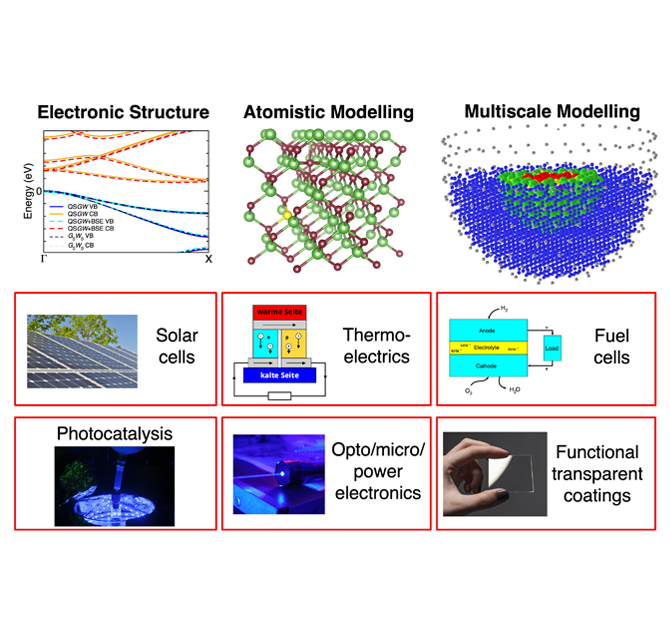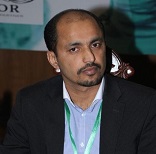
Research
LCEE is a research organisation undertaking innovative, cutting-edge and multidisciplinary energy research.Research themes

Computational Materials Design for Energy
Understanding materials at the atomic scale is critical to the design of next generation energy devices. Modern computational chemical and physical techniques can be employed to predict for example the electronic and optical properties of an active layer in a device, the dopability of a semiconductor, or the efficiency and mechanism of catalytic processes on the surface of a material. At the LCEE, the team works closely with experimentalists to develop novel photocatalysts, energy generation and storage devices, functional thin film coatings and microelectronics, utilising our in-house supercomputer, and national high performance computing resources. LSBU is part of a multi-partner £1M UKRI-funded project to investigate novel computational methods for next-generation exascale computing. We are also active in developing sustainable computational and synthetic techniques.

Heating and Cooling
The Heating and Cooling team has a 30-year history of attracting high impact research projects and contracts from EPSRC, Government, the EU and the RACHP (refrigeration air conditioning and heat pump industry). In the past 10 years we have secured and delivered more than 60 small to large scale projects. The team are currently involved in several prestigious research projects in collaboration with the local and international organisations, the EU, public and governmental international organisations. Recent collaborations have involved a £5.2 million EPSRC project of which LSBU received £1.2 million and a €7 million EU research grant to develop a ground-breaking energy storage technology. Our funding strategy involves working on TRL levels 4-8, developing partnerships with other Universities as well as with industry and aligning our activities with future funding priorities like the Industrial Strategy Clean Growth Plan.

Energy Storage
As the UK and the rest of the world moves towards renewable energy, supply becomes more dependent on factors outside the control of the energy supplier.
Cryogenic energy storage (CES): One method to balance supply and demand in power generation is to store energy during periods of low demand and use it at high demand. Cryogenic energy storage makes use of low-temperature liquids as an energy storage and transfer medium. CES can provide large-scale, long-duration energy storage of 5 to 1000 MWh. LCEE team members are working on a multi-partner £8M H2020 project to develop CES at cold storage warehouses.
Batteries and supercapacitors: Our team also works in the development of batteries (Li -ion and beyond) and supercapacitors focusing on-demand bespoke tailoring of the functional properties of electrode materials (theoretical and experimental) to deliver advancements in their application.

Energy Conversion
In response to advancing climate change and energy crisis concerns, immediate measures are needed to minimize our dependency on fossil fuels and speed the transition to a low-carbon economy. Solar energy for example can provide an effective and sustainable solution to both energy and environmental crises. Our team is involved in the following areas:
Photovoltaics: Solar cells (perovskite, organic and inorganic based). The research is focused on the development of solar cells, LEDs, and on understanding the physics of materials and devices, with the aim of improving them.
Renewable fuel production: Photocatalysis, can readily harness freely available clean solar energy (in the presence of a catalyst) to generate hydrogen and oxygen by the splitting of water or reduced carbon compounds from carbon dioxide. Alternatively, we use pyroelectric or multiferroic/magnetoelectric materials to generate hydrogen from transient low-grade waste heat (<100°C) or in the presence of magnetic field, respectively.
Highlighted Publications
 Dr Suela Kellici
Dr Suela Kellici
 Dr Deborah Andrews
Dr Deborah Andrews
 Dr John Buckeridge
Dr John Buckeridge
 Prof. Steve Dunn
Prof. Steve Dunn
 Prof. Judith Evans
Prof. Judith Evans
Biglia, Alessandro, Gemmell, Andrew J, Foster, Helen J and Evans, Judith A (2020). Energy performance of domestic cold appliances in laboratory and home environments. Energy. https://doi.org/10.1016/j.energy.2020.117932
 Dr Chiara Gattinoni
Dr Chiara Gattinoni
 Prof. Saurav Goel
Prof. Saurav Goel
 Prof. Graeme Maidment
Prof. Graeme Maidment
Marques, C., Dunham, C., Jones P., Marques, C., Dunham, C., Jones, P., Matabuena, R., Revesz, A., Roscoe Papini Lagoeiro, H. and Maidment, G. (2019). Integration of high temperature heat networks with low carbon ambient loop systems. 2021 ASHRAE Winter Virtual Conference . 09 - 12 Feb 2021 https://doi.org/10.18462/iir.icr.2019.XXX
 Prof. Simon Philbin
Prof. Simon Philbin Dr Tariq Sajjad
Dr Tariq Sajjad Prof. Hari Upadhyaya
Prof. Hari Upadhyaya